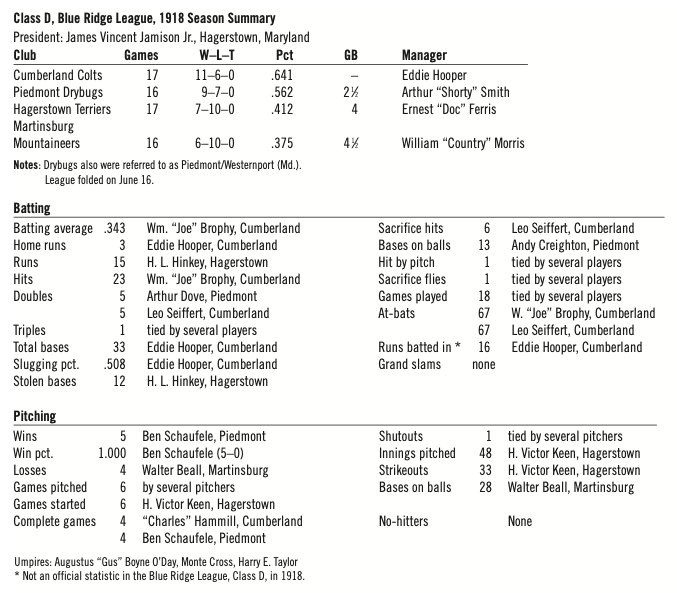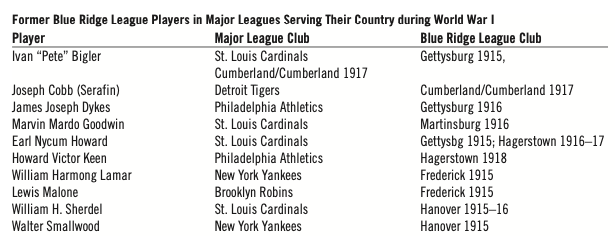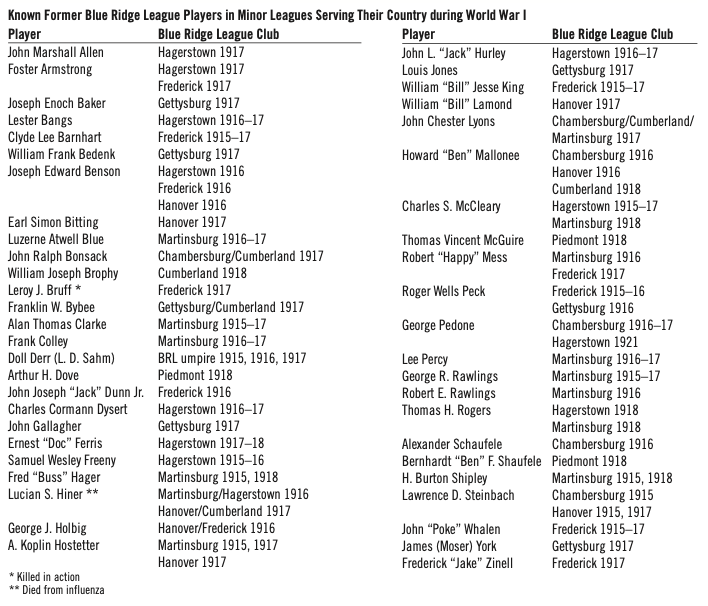The Class D Blue Ridge League: 1918, the Lost Season
This article was written by Mark Ziegler
This article was published in The National Pastime: Monumental Baseball (Washington, DC, 2009)
The Great War in Europe had finally reached the shores of the United States in 1917, and when the time came for baseball leagues to plan for the following season, many able-bodied young men had already signed up to serve their country. With a short age of players and finances, many leagues had folded by the time the 1917 season officially ended.
BLUE RIDGE: THE ONLY CLASS D LEAGUE LEFT STANDING
When the 1918 season began, only ten leagues in all of the classifications started play. The Blue Ridge League was the only Class D league in operation. The other leagues remaining included the three Class AA leagues: American Association, International, and Pacific Coast; two Class A leagues: Southern and Western; three Class B leagues: Eastern, Pacific Coast International, and Texas; and one Class C league, Virginia.
Unfortunately, as the war effort continued, leagues were forced to suspend operations or disband due to lack of players and finances by the individual clubs. By September, the only baseball being played came from the two major leagues and the Class AA International League.
The Class D Blue Ridge League, under the leader ship of James Vincent Jamison Jr. had many uphill battles to start the season, but with a little creativity and help from a few new sources, began the season that, unfortunately, would not last very long.
BLUE RIDGE LEAGUE LOSES SEVERAL MEMBERS
When the 1917 season ended, the financially insolvent Gettysburg, Pennsylvania, club ceased operations. With the addition of the Cumberland, Maryland, franchise in July of 1917, the Hanover, Pennsylvania, club complained about inconveniences and travel costs in trekking such a long distance to that Western Mary land town. With Gettysburg no longer in the league, Hanover soon dropped out, citing financial concerns and the lack of resources to properly field a team.
On March 6, 1918, the league moguls met at the Hamilton Hotel in Hagerstown, Maryland, to decide the fate of the league. With Hagerstown, Cumberland, and Frederick verbally committing to field teams, it was decided then to field four teams, with Martinsburg of West Virginia agreeing to become the fourth league club. The representatives of each club were Colonel N. Russler of Cumberland, Frank K. Schmidt of Frederick, J. C. Roulette, T. B. South, and W. C. Conley of Hagerstown, and C. A. Miller, E. C. Shepherd, and Max von Schlagel of Martinsburg.
With four clubs agreeing to begin play, the league looked like it would continue until two weeks before the beginning of the season. On May 10, Schmidt announced that the Frederick club would not be able to field a team for the 1918 season due to the lack of enthusiasm and financial support, because their sup porters were concentrating efforts on the war overseas.
SCRAMBLING TO FIELD ENOUGH TEAMS
With Frederick’s unexpected announcement, president Jamison was forced to scramble to find enough teams to continue the league. He had previously invited representatives from York, Carlisle, and Harrisburg, Pennsylvania, to join the league, but they declined due to travel and financial concerns.
The Chambersburg team, who had moved their franchise the previous June 30 to Cumberland, was also touted as a possible replacement, but their home ballpark, known as Wolf Park, had been plowed up and was being used for agricultural purposes, leaving them with no place to play. Luckily for Jamison and the league, tiny Piedmont, located along the Potomac River in Allegany County, Maryland, near Westernport, agreed on May 13 to field the fourth team to keep the league alive. The league rescheduled their opening day for May 28, which gave Piedmont just two weeks to field a team and prepare a field to play.
THE MANAGERS ON THE FIELD
The four managers selected at the beginning of the season included veteran William G. “Country” Morris, who was starting his fourth season as manager of the Martinsburg club; Eddie Hooper, who managed the 1916 league championship team and part of the 1917 season in Chambersburg, until the club was transferred to Cumberland, and who returned to manage the Cumberland club; veteran pitcher Ernest “Doc” Ferris, who managed Hagerstown; and infielder Arthur “Shorty” Smith, who managed the new Piedmont club. Piedmont tried to hire adopted native son and former major-leaguer Bill “Baldy” Louden, but was caught in a dispute with his former club, Minneapolis, when they would not release him from his contract. When the AA club later offered Louden for $1,000, the Piedmont club said “No, thanks” and kept Smith at the helm.
DRYBUGS JOIN BRL RANKS
Hagerstown continued to use the moniker “Terriers” for the 1918 season, while Martinsburg stayed with “Mountaineers,” and Cumberland with “Colts.” The Piedmont/Westernport club decided to name them selves the “Drybugs,” for the nickname they used during their one season in the defunct Class D Potomac League in 1916. The team played their home games at Potomac Field on the Maryland side of the banks of the Potomac River, but the club’s offices were officially located on the West Virginia side. The “dry bug” was supposedly an insect that was known to habitate in that region of the Potomac River.
1918 SEASON OPENS
When the league opened on May 28 in Hagerstown, it featured an entirely different look, as many players from the season before had signed up for the armed services or were playing on different clubs. Martins burg’s Roy Myers won a rain-shortened season opener over the Terriers, 3 to 1, in a game that featured former Frederick Hustlers manager Tom Crooke playing for the Mountaineers. In the other season opener, the Colts defeated Piedmont 9 to 6 in Cumberland. The Drybugs were short one outfielder for the game, and “borrowed” Cumberland’s Joe Raley to play for the visitors. Eddie Hooper hit a home run for the Colts.
A FEW GOOD MEN
As the season started, several prospects started to emerge; however, the war effort quickly began to take its toll on the young men playing ball in the Blue Ridge League. Martinsburg’s top slugger, Fred “Buss” Hager, and H. “Ben” Mallonee of Cumberland both were called to active duty less than one week into the season, which followed a pattern that would plague the league’s officials in trying to field quality teams.
PIEDMONT DILEMMA
Trouble brewed just before the first week of play was completed for the new Piedmont club. After the fifth game of the season, Piedmont was in first place, but six members of the 13man Drybugs announced to manager “Shorty” Smith that they were quitting the club to return home for higher-paying jobs. All these players were from the Baltimore, Maryland, area, including his top five players, third baseman Arthur Dove, outfielders Hiram Kurtz and “Roger” Maul, first baseman Elmer Williams, and pitcher Ben Schaufele.
One player, infielder Andy Creighton, did respond to Smith’s pleas to stay, and returned to the club after a two-game absence. Schaufele made appearances during the weekend games, winning a league-high five games, but the disruption caused discontent among the remaining players, which was a precursor of what was happening around the league at the time. For the next couple of weeks, the Drybugs roster looked like a revolving door of players, with only Smith and Creighton playing more than eight games.
PROSPECTS
Hagerstown pitcher Howard Victor Keen, an Eastern Shore teenager from Snow Hill, joined the Terriers, and instantly became a popular player in the Hub City, along with becoming one of the league’s better pitchers. In five starts, Keen led all pitchers with 33 strikeouts when the league disbanded in mid-June. The Terriers catcher, Douglas “Dixie” Parker, was also impressive, and along with teammates Keen and William D. “Snooks” Han ratty caught on with the Petersburg, Virginia, club of the Class C Virginia League after the BRL folded. When the Virginia League folded on July 20, Keen signed with the International League’s Baltimore Orioles. Before he played a game for the Orioles, Keen was called up by Connie Mack to pitch one game for the American League’s Philadelphia Athletics, when the club was in desperate need of pitching. Parker, an Alabama native, also went on to play four games in the majors with the Philadelphia Phillies in 1923.
Despite struggling both on and off the field, the Martinsburg club did feature a future member of the 1927 World Champion New York Yankees. Walter Beall, an 18-year-old from Washington, D.C., who made his professional debut in the Blue Ridge League as a 15year old in 1915, lost all four of his decisions with the last-place Mountaineers. Beall, who led the International League in strikeouts and ERA in 1923 by beating out “Lefty” Grove for top honors, would spend four seasons with the Yankees, from 1924 to 1927, and was a teammate of Babe Ruth and Lou Gehrig.
Piedmont’s Ben Schaufele had the distinction of being the only pitcher to win five games, despite pitching mainly on the weekends. Cumberland player/ manager Hooper and third baseman Joe Brophy were among the league’s best batters, and second baseman Leo Seiffert was among the league’s best fielders.
One of the strangest games of the season was on June 1, when Cumberland scored three unearned runs in the first inning to defeat Hagerstown 3 to 1, despite getting only one hit off Terriers’ pitcher, George Zinn. Two of the best games of the season came off the arm of Piedmont’s “Stub” Brown, who tossed back-to-back shutouts. Brown won a 1–0 pitcher’s duel against Cumberland’s Charles Hammill on June 2, and came back five days later to toss a two-hit shutout at Martinsburg, defeating Mountaineers hurler “Robert” Fitch, 2–0.
MYSTERIOUS ENDING
The Martinsburg club was on shaky ground financially when the season started. When they experimented with twilight game times they realized that their attendance at the gate did not improve, and their officials, realizing that they were in a losing proposition with a lack of attendance and increased travel costs, devised a plan that led to the demise of the league on June 15. As other remaining minor leagues began to feel the pressures to disband due to the concentrated war effort, the sentiment was similar to that of some of the officials in the Blue Ridge League.
The league was in its second week when Martins burg called a meeting of the four member clubs in the West Virginia town. Piedmont, not realizing the urgency of the meeting, sent a proxy to league president Jami son, and Cumberland was not aware of the details of the meeting. That would prove fatal, as Martinsburg’s officials had planned to convince the discontinuance of the league less than three weeks into the season. Hagers town club president J. C. Roulette was confined to his bed with a serious illness, and his vice president, Thomas B. South, was sent to represent the Terriers. Martinsburg officials took advantage of this situation, and convinced South to agree with them to suspend the remainder of the season due to the war effort. With Cumberland and Piedmont against disbanding, the final vote rested with President Jamison, who eventually agreed with Martinsburg that it would be in everyone’s best interest to suspend operations.
PIEDMONT AND CUMBERLAND’S LAST GAME
The weekend of June 15–16 turned out to be the last games of the season, and the last of Piedmont and Cum berland in the Blue Ridge League. On Saturday, June 15, Hagerstown defeated the Drybugs 4 to 3, while Cumberland defeated Martinsburg, 5–0 behind a five-hit shutout by “Lefty” Block. Piedmont defeated the Colts at Cumberland, in the league’s final game played on Sunday, June 16. The Colts (1 –6) had the best record of the suspended season, but received no accolades, since the season would be considered incomplete, as the league had lasted less than three weeks.
Cumberland, still furious over the way Martinsburg “hoodwinked” the other league members to disband, announced that they would keep their club, and play independent ball for the remainder of the season. That resentment would run deep, as Colonel Nelson Russler vowed that his Cumberland club would never return to the Blue Ridge League.
QUIET AT THE BAT
When the season ended after the seventeenth scheduled game, Hagerstown (7–10) batters had the distinction of not hitting any triples or home runs during the 1918 season.
Martinsburg also did not hit any home runs during the season. Hooper, the Colts player/manager, led the league with three roundtrippers, in a year where only five home runs were hit in the entire league. The other two came from Piedmont’s Arthur “Shorty” Smith and “Mike” Preston.
WHERE DO WE GO FROM HERE?
With the abrupt end to professional baseball in the Blue Ridge, those players and officials not signing to join the armed services had to find alternatives.
The area Industrial Leagues, especially in Hagerstown, Maryland, and Waynesboro, Pennsylvania, soon recruited several of the former Blue Ridge League players to work and play for their company teams. Among them included pitchers Chalkey McCleary, Hanson Horsey, Walt Herrell, and outfielder Bill Sykes. The Blue Ridge League’s demise was a boon to the area Industrial Leagues, who drew fans wanting to see good baseball. Some players, including former Hanover infielder Toney Citrano, who played for the Baltimore Dry Docks, worked and played for the railroad-owned baseball teams in Baltimore and Philadelphia. Several others, like J. Roy Clunk and George W. “Buck” Ramsey, played in railroad leagues in central Pennsylvania. In some areas, the local church leagues also saw an increase of misplaced ballplayers on their teams.
In Cumberland and Piedmont, an independent league schedule was formed with the neighboring West Virginia towns of Clarksburg and Fairmont, to serve those communities’ interest in the sport. Manager Eddie Hooper was one of the few Cumberland players who left the club after the league folded, deciding to sign with the Binghamton, New York, club in the Class AA International League. He was one of several former Blue Ridge League players who found themselves on International League rosters, along with Hooper’s former Chambersburg teammate from 1916, Karl Kolseth, and his former Hagerstown teammate from the previous season, Charles Dysert. Kolseth split time between the Baltimore, Maryland, and Newark, New Jersey, clubs, and Dysert spent a month with the Baltimore club. Several other players moved to the Class B Virginia League, which did not disband until later in the summer. Among them was Hagerstown pitcher “Vic” Keen, who was signed by Philadelphia’s Connie Mack, and pitched for four different leagues while making his major-league debut with the Athletics late in the 1918 season.
NO BASEBALL IN 1919
Though an attempt was made by officials of the Frederick and Martinsburg clubs to bring back the league, the after effects of the war, the flu epidemic that raged throughout the country during the latter part of 1918, and the limited resources and finances of the other former league towns kept the Blue Ridge League from returning in 1919.
Sources
Spalding and Reach Baseball Guides, 1917, 1918, 1919.
Daily newspaper articles, 1917 and 1918, from the following: Cumberland (Md.) Times, Hagerstown (Md.) Mail, Martinsburg (W.Va.) Journal, (Chambersburg, Pa.) Public Opinion, Gettysburg (Pa.) Times, Frederick (Md.) News, Frederick (Md.) Post, (Hanover, Pa.) Record Herald, Washington Post.
World War I Veterans in Maryland. Volumes 1 and 2. Baltimore, 1933.
Acknowledgments
Special thanks to Mary Jo Foster, Frostburg State University Library; Marry Mannix and Darrel Batson, Maryland Room, C. Burr Artz Library, Frederick, Maryland; John Frye, Western Maryland Room, Washington County Public Library, Hagerstown, Maryland; Minor League Baseball, St. Petersburg, Florida; Lloyd Johnson and Miles Wolff, The Minor League Baseball Encyclopedia, 2d edition; Ken Malnar, 270net.com, www.newspaperarchive.com; Society of American Baseball Research and its members.
Class D, Blue Ridge League, 1918 Season Summary
(Click image to enlarge)
Former Blue Ridge League Players in Major Leagues Serving Their Country during World War I
(Click image to enlarge)
Known Former Blue Ridge League Players in Minor Leagues Serving Their Country during World War I
(Click image to enlarge)





